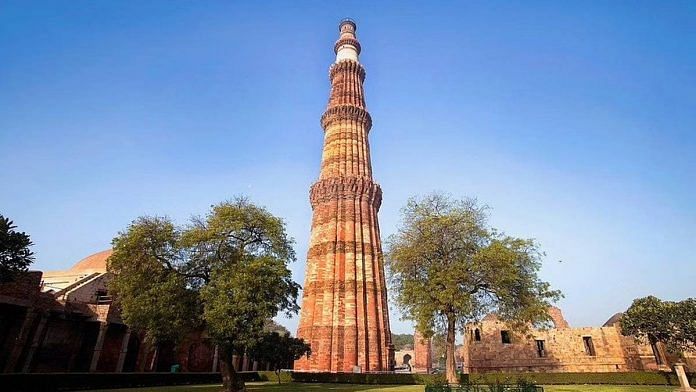New Delhi: The Archaeological Survey of India (ASI) has told a Delhi court that the Qutub Minar is “not a place of worship”, and that nobody can claim a fundamental right to worship in a centrally protected monument.
The ASI made the statement in an affidavit filed in the court Monday, in response to a plea challenging a December 2021 order that had rejected a civil suit seeking restoration of Hindu and Jain deities, and the right to worship within the Qutub Minar complex.
“…Since the time of its protection from the central government, the Qutub Minar or any part of it was not under worship by any community,” the ASI said, adding that “there is no denial of the fact that there are a number of sculptures existing within the Qutub Minar complex”.
According to the affidavit, “architectural members and images of Hindu and Jain deities are re-used in the construction of the Qutub complex”. This, it said, is “very clear from the inscription in the complex which is open to public viewing”.
However, it said that it would be contrary to the provisions of the Ancient Monuments and Archaeological Sites and Remains Act, 1958, “to agree to the contention of the respondents or any other person claiming a fundamental right to worship in this centrally protected monument”.
There is no provision under the 1958 Act “under which worship can be started at any living monument”, the affidavit stated.
The affidavit further submitted that the “basic principle of protection/conservation is not to allow starting of any new practice in a monument declared and notified as a protected one under the Act”.
“Revival of worship is not allowed wherever it is not practised at the time of protection of a monument,” it added.
The civil suit rejected last December was filed on behalf of Hindu deity Lord Vishnu, Jain deity Tirthankar Lord Rishabh Dev, and others. The plaintiffs had contended that Qutb-ud-din-Aibak had “dismantled, desecrated and damaged” a Shree Vishnu Hari temple and 27 Jain and Hindu temples to then build the Quwwat Ul Islam Mosque in the Qutub Minar complex.
While rejecting the suit, civil judge Neha Sharma of the Saket court had asserted that India “has a rich history” and “has been ruled by numerous dynasties”. She had then observed: “Nobody has denied that wrongs were committed in the past, but such wrongs cannot be the basis for disturbing the peace of our present and future.”
“Our country has a rich history and has seen challenging times. Nevertheless, history has to be accepted as a whole. Can the good be retained and bad be deleted from our history?” the court had asked.
Also read: Gyanvapi row and Places of Worship Act were born together. Now each wants to end the other
‘Changing the structure would violate law’
The ASI affidavit also informed the court that the Qutub complex was notified as a protected monument through a January 1914 notification issued under the Ancient Monuments Preservation Act, 1904.
Section 3 of the Ancient Monuments and Archaeological Sites and Remains (AMASR) Act, 1958, brings all monuments under the 1904 Act under its ambit. The affidavit said that the 1958 law, therefore, would also apply to the complex.
It then pointed out that the 1958 Act makes the area “beginning at the limit of the protected area or the protected monument… and extending to a distance of 100 metres in all directions” a prohibited area.
No one other than an archaeological officer can carry out any construction in the prohibited area, the 1958 Act states.
“The intention of the statute is clear that the monument should be protected and preserved in its original condition for posterity. Therefore, changing and altering of the existing structure would be a clear violation of the AMASR Act, 1958, and thus should not be allowed,” the affidavit said.
(Edited by Gitanjali Das)
Also read: A temple in the Taj Mahal? What Mughal-era documents tell us about tangled claims



